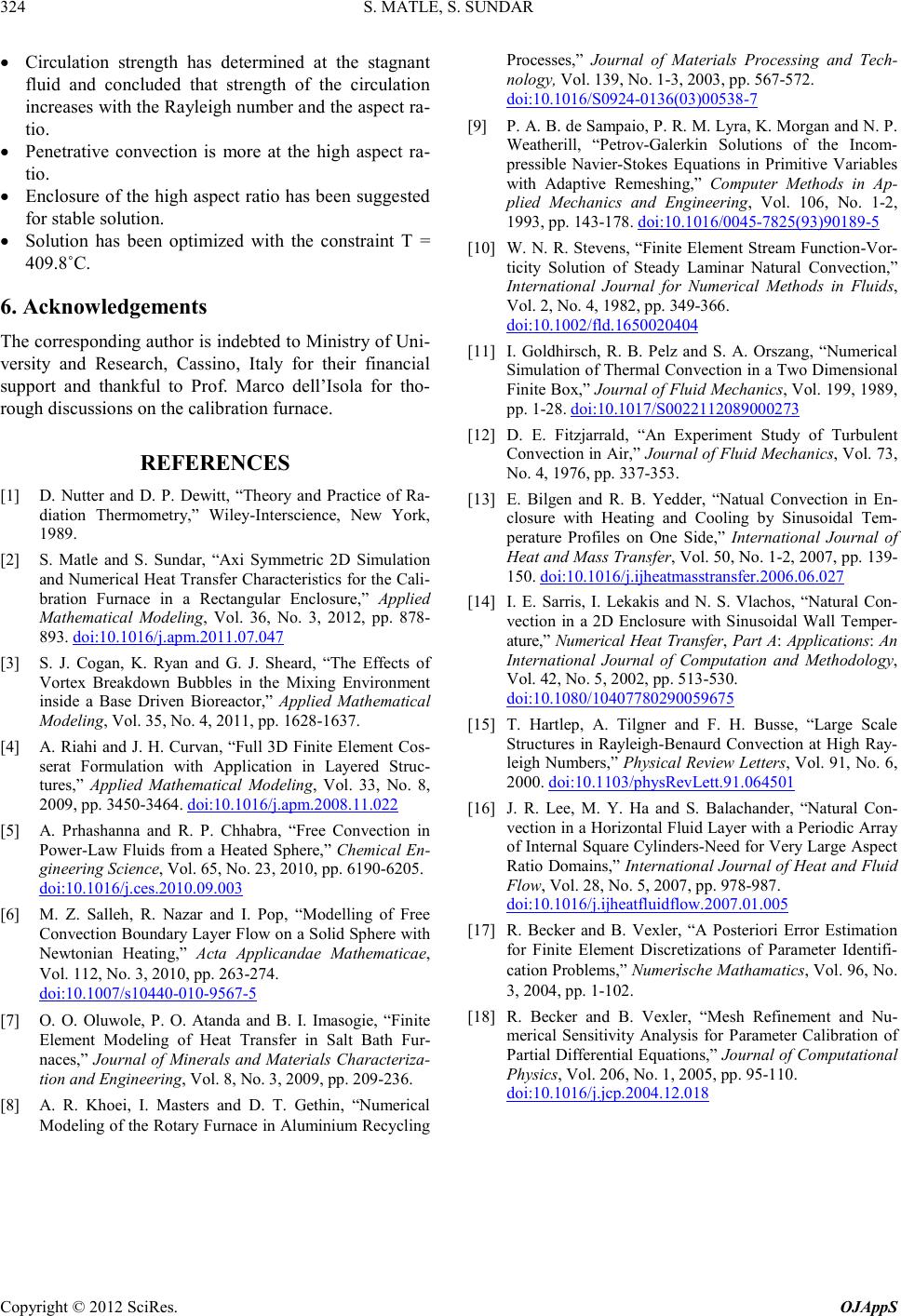
S. MATLE, S. SUNDAR
Copyright © 2012 SciRes. OJAppS
• Circulation strength has determined at the stagnant
fluid and concluded that strength of the circulation
increases with the Rayleigh number and the aspect ra-
tio.
• Penetrative convection is more at the high aspect ra-
tio.
• Enclosure of the high aspect ratio has been suggested
for stable solution.
• Solution has been optimized with the constraint T =
409.8˚C.
6. Acknowled ge ments
The corre spond ing autho r is indebted to Ministry of Uni-
versity and Research, Cassino, Italy for their financial
support and thankful to Prof. Marco dell’Isola for tho-
rough discus sions on the calibration furnace.
REFERENCES
[1] D. Nutter and D. P. Dewitt, “Theory and Practice of Ra-
diation Thermometry,” Wiley-Intersci en ce, New York,
1989.
[2] S. Matle and S. Sundar, “Axi Symmetric 2D Simulation
and Numerical He at Transfer C haracteristics for the Cali-
bration Furnace in a Rectangular Enclosure,” Applied
Mathematical Modeling, Vol. 36, No. 3, 2012, pp. 878-
893. doi:10.1016/j.apm.2011.07.047
[3] S. J. Cogan, K. Ryan and G. J. Sheard, “The Effects of
Vortex Breakdown Bubbles in the Mixing Environment
inside a Base Driven Bioreactor,” Applied Mathematical
Modeling, Vol. 35, No. 4, 2011, pp. 1628-1637.
[4] A. Riahi and J. H. Curvan, “Full 3D Finite Element Cos-
serat Formulation with Application in Layered Struc-
tures,” Applied Mathematical Modeling, Vol. 33, No. 8,
2009, pp. 3450-3464. doi : 10.1016/j.apm.2008.11.022
[5] A. Prhashanna and R. P. Chhabra, “Free Convection in
Power-La w Fluids from a Heated Sphere,” Chemical En-
gin eering Science, Vol. 65, No. 23, 2010, p p. 6190-6205 .
doi:10.1016 / j . c es . 2010. 09.003
[6] M. Z. Salleh, R. Nazar and I. Pop, “Modelling of Free
Convection Boundary Layer Flow on a Solid Sphere with
Newtonian Heating,” Acta Applicandae Mathematicae,
Vol. 112, No. 3, 2010, pp. 263-274.
doi:10.1007 / s10440-010-9567-5
[7] O. O. Oluwole, P. O. Atanda and B. I. Imas ogie, “Finite
Element Modeling of Heat Transfer in Salt Bath Fur-
naces,” Journal of Minerals and Materials Characteriza-
tion and Engineering, Vol. 8, No. 3, 2009, pp. 209-236.
[8] A. R. Khoei, I. Masters and D. T. Gethin, “Numerical
Modeling of the Rotary Furnace in Aluminium Recycling
Processes,” Journal of Materials Processing and Tech-
nology, Vol. 139, No. 1-3, 20 03, pp. 567-572.
doi:10.1016 / S 0924-0136(03)00538-7
[9] P. A. B. d e Sampaio , P. R. M. Lyr a, K . Morgan and N. P.
Weatherill , “Petr o v-Galerkin Solutions of the Incom-
pressible Navier-Stokes Equations in Primitive Variables
with Adaptive Remeshing,” Computer Methods in Ap-
plied Mechanics and Engineering, Vol . 106, No. 1-2,
1993, pp. 143-178. doi:10.1016/0045-7825(93)90 18 9-5
[10] W. N. R. Stevens, “Fini te Element Stream Function-Vor-
ticity Solution of Steady Laminar Natural Convection,”
International Journal for Numerical Methods in Fluids,
Vol. 2, No. 4, 1982, pp. 349-366.
doi:10.1002 / fld.16 500204 04
[11] I. Goldhirsch, R. B. Pelz and S. A. Orszang, “Numerical
Simulation of Thermal Con vection in a Two D imensional
Finite Box,” Journal of Fluid Mechanics, Vol . 199, 1989,
pp. 1-28. doi:10.1017/S0022112089000273
[12] D. E. Fitzjarrald, “An Experiment Study of Turbulent
Convectio n in Air,” Jou rnal of Fluid Mechanics, Vol. 73,
No. 4, 1976, pp. 337-353.
[13] E. Bilgen and R. B. Yedder, “Natual Convection in En-
closure with Heating and Cooling by Sinusoidal Tem-
perature Profiles on One Side, ” International Journal of
Heat and Mass Transfer, Vol. 50, No. 1-2, 2007, pp. 139-
150. doi:10.1016/j.ijheatmasstransfer.2006.06.027
[14] I. E. Sarris, I. Lekakis and N. S. Vlachos, “Natural Con-
vection in a 2D Enclosure with Sinusoidal Wall Temper-
ature,” Numerical Heat Transfer, Part A: Applications: An
International Journal of Computation and Methodology,
Vol. 42 , No. 5, 2002, pp. 513-530.
doi:10.1080 / 104077 80290059675
[15] T. Hartlep, A. Tilgner and F. H. Busse, “Large Scale
Stru ctu r es in Rayleigh-Benaurd Convection at High Ray-
leigh Numbers,” Ph ysical Review Letters, Vol. 91, No. 6,
2000. doi:10.1103/physRevLett.91.064501
[16] J. R. Lee, M. Y. Ha and S. Balachander, “Natural Con-
vection in a Horiz onta l Flui d Layer with a Periodic Array
of Internal Square Cylinders -Need for Very Large Aspect
Ratio Domains,” International Journal of Heat and Fluid
Flow, Vol. 28, No. 5, 2007, pp. 978-987.
doi:10.1016/j.ijheatfluidflow.2007.01.005
[17] R. Becker and B. Vexler, “A Posteriori Error Estimation
for Finite Element Discretizations of Parameter Identifi-
cation Problems,” Nu m erische Mathamatics, Vol. 96, No.
3, 2004, pp . 1-102.
[18] R. Becker and B. Vexler, “Mesh Refinement and Nu-
merical Sensitivity Analysis for Parameter Calibration of
Partial Differential Equations,” Journal of Computational
Physics, Vol. 206, No. 1, 2005, pp. 95-110.
doi:10.1016 / j . jcp.20 04.12 .0 18